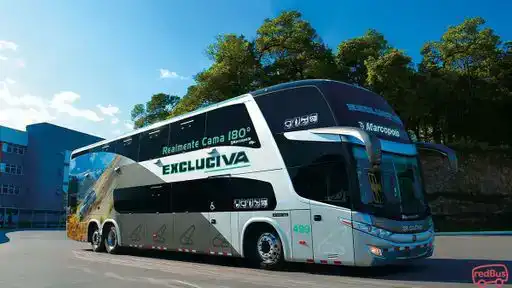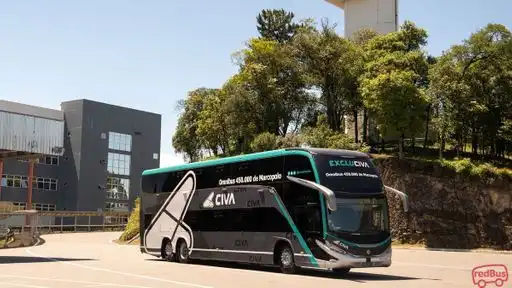Nazca to Marcona Bus
OUR PROMISE
SECURE PAYMENT
redBus has secure payments and keeps your information and purchases completely safe and secure.
ATTRACTIVE DEALS
Get amazing discounts every time you book with redBus
WIDE CHOICE OF BUSES
150+ Bus companies with 800+ Routes in Perú
Nazca to Marcona Bus Service
Avg. Bus Duration
:1 hrs 14 mins
Buses depart from
:Nazca
Bus arrives in
:Marcona
Cheapest Bus
:PEN 110.00
Bus Companies
:Excluciva
Earliest Bus
:03:40
Last Bus
:03:40
Daily Bus Services
:1
Buy Nazca to Marcona Bus Tickets Online - Unlock Extra Savings with redDeals on redBus
Reserve a bus from Nazca to Marcona with redBus, Peru, and grab exclusive redDeals. Choose from 103 deals on 30 bus operators and avail yourself of discounts up to 25% on your bus travel!
Nazca to Marcona Bus
#N/A
Top Bus Operator Images





OTHER BOARDING & DROPPING POINTS IN
Nazca
- Terminal Nazca
Marcona
- Terminal Marcona
Why book a Nazca to Marcona bus with redBus?
You can also time-to-time redBus offers while booking your bus tickets online from Nazca to Marcona. Follow a simple, fast and secure bus booking procedure. This helps save time and also helps to create a joyful travel experience!
About Nazca
At the current territory of Nazca flowered on the 1st century A.D. the Nazca culture. The researches and exploration of places and remains left by this culture indicate that this would be a direct continuation of the Paracas culture. Unlike the Paracas, who developed until perfection the textile art, the Nazca were the masters of pottery, standing out also for the hydraulic engineering present in the aqueduct construction (which is still used nowadays) and the impressive geoglyphs, which are known as the Nazca Lines. Between 700 and 900 A.D. took place the decadence of the Nazca culture, due to natural reasons. In 1901, the German archaeolologist Max Uhle discovered the potter legacy of the Nazca, which dates from 200, 500 and 700 D.C. Subsequently, in 1939, the American Paul Kosok would discover, without plnanning it, the Nazca Lines, while he was overflying the desert where they are.
About Marcona
In 1850 occured at the coast of Punta de San Juan city (today Marcona) the accident of the first Peruvian steamboat BAP Rimac, in which hundreds of people died, being a survivor the writer Ricardo Palma.In 1870 the researcher Antonio Raimondi recognized that there were numerous iron deposits in the area, but it was in 1915 that the explorations started. In 1943 was created the Corporacion Peruana del Santa to take advantage of the resources of the area and years later there were international companies that joined, creating the first mining camp.During the government of Juan Velasco Alvarado the deposit that was used for 17 years was nationalized and from the first government of Alberto Fujimori the Corporacion Shougang de China is in charge of the area until nowadays.
FAQs
How can I make an online bus ticket booking in Peru?
You can book a bus of your choice to any destination in Peru by logging on to the official website of redBus which is redbus.pe/en/ . The site is user-friendly and you can book your bus ticket in a matter of minutes.
How do I book a bus from Nazca to Marcona?
You can either visit the terminal and go the booth belonging to the bus operator of your choice, wait in line, select a seat, and book your ticket. If you’d rather not do that, you can visit redbus.pe/en/ and book your seat within 5 minutes.
Do I need to print out my bus ticket before boarding?
There are two main scenarios that you might fall into when you have to board a bus. Now, if your boarding point is at any terminal in redbus.pe/en/ , passengers will have to take a print out of the bus ticket that has been sent to the email in a PDF format. The second scenario is when your boarding point is a bus stop and not a terminal. In this case, you will receive an M-ticket that you will have to produce before boarding your bus. If the operator does not provide an M-Ticket, you will have to take a printout of the ticket (PDF) that has been sent to the registered email ID that you have used to book the bus ticket on the redBus website. Some operators might levy a charge if these conditions are not followed.
Can I reschedule my journey after I have booked my ticket?
Yes, you can. But this feature is limited to only a few bus operators in Peru. Look for the reschedule icon before booking your ticket.
How do I pay for my bus ticket on the redBus website?
There are a number of different modes of payment offered to customers. Customers can either pay by credit card, debit card, or they can select any of the banks listed when you click the “FPX (Peru Online Bank Transfer).
Popular Bus Routes from Nazca
Popular Bus Routes to Marcona
Top Bus Operators in Nazca
Top Bus Operators in Marcona
Other Bus Routes From Nazca
Nazca to Terminal Terreste Mollendo BusNazca to Terminal Chalhuanca BusNazca to San Isidro BusNazca to Terminal Terrestre Cusco BusNazca to Terminal Plaza Norte BusNazca to Cusco BusNazca to Tacna BusNazca to Ica BusNazca to Arequipa BusNazca to Paracas BusNazca to Camaná BusNazca to Av. Paracas BusNazca to Terminal Ica BusNazca to Javier Prado BusNazca to Terrapuerto Arequipa BusNazca to Lima BusNazca to Terminal Terrestre Tacna BusNazca to Terminal Desaguadero BusNazca to Terminal Terrestre De Juliaca Busmore >>
Other Bus Routes To Marcona
Other Bus Routes
San marcos (ancash) to Chavin BusTarapoto to Chao BusPuerto Maldonado to Puno BusLima to Terminal Moquegua BusLambayeque to Tumbes BusNaranjos to Hualapampa BusAgencia Motupe to Cruce Olmos BusNuevo chimbote to Breña BusCañete to La Victoria BusTerminal Terrestre Tacna to Desaguadero BusPedro Ruiz to Bagua Grande BusSullana to Terminal Mancora BusMocupe to Lima BusTomas Valle to Barranca BusLima to Terminal Terrestre Ciudad Constitucion BusTerminal Terrestre El Chimbador to Av. Progreso BusTingo María to Saposoa BusMollendo to Javier Prado BusAv Juan Pablo to Sullana BusTerminal Ilo to Terminal Nazca Busmore >>
Other Bus Operators
PalominoTransAmazonicaJean BussLeviturTransportes DakarGH BusTransportes Libertadores
Señor de AtacoPajatenTranssalvadorTurismo CañeteVia Expres NacionalTransportes VSMCruzero ExpressTurismo RarazIntur MachupicchuTransportes LibertadTransportes NazarenoExpreso Internacional MolinaTransporte Salazarmore >>